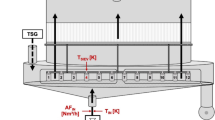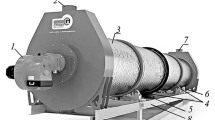Abstract
Using vibro-fluidized bed dryers (VFB) is an alternative to perform drying with less specific energy consumption compared to fluidized bed dryers (FB). Finding an optimum combination of the dimensionless vibrating number (Γ) with the drying conditions is a key factor to analyze the viability of VFB towards energy efficiency. In the present study, the performance of a VFB was investigated by correlating the drying kinetics of porous particles with the specific energy consumption to obtain an optimum drying condition. Experiments were carried out under different operating conditions and three combinations of vibration amplitude (A) and frequency (F) chosen to yield a constant value of Γ. The impact of the operating parameters was analyzed by effective moisture diffusivity (Deff,G), estimated by fitting the diffusive model to the experimental data. It was found that vibration intensifies Deff,G and is the preponderant effect in the convective mass transfer. Different values of Deff,G were found for the same Γ obtained under the tested combinations of A and F, which indicates that this parameter cannot be used alone as a single descriptor of the vibration energy. Using a high temperature and a gas velocity exceeding the minimum fluidized velocity combined to a higher value of A and a lower value of F enhanced drying, as this combination yielded the highest Deff,G. This same combination of high A and low F associated to low values of temperature and gas velocity enhanced the energy performance. The results also showed that only Γ is not an adequate parameter to perform energy analysis of VFB.







Similar content being viewed by others
Abbreviations
- a:
-
Activity [−]
- A:
-
Amplitude of vibration [m]
- Bi:
-
Mass transfer biot number [−]
- cpg :
-
Specific heat of dry air [kJ/kg°C]
- C:
-
Concentration [kg m−3]
- Cl :
-
Liquid concentration [kg m−3]
- Cv :
-
Vapor concentration [kg m−3]
- D:
-
Diffusion coefficient [m2 min−1]
- D0 :
-
Pre-exponential factor [m2 min−1]
- Deff,G :
-
Effective moisture diffusivity (global) [m2 min−1]
- Deff,k :
-
Effective Knudsen diffusivity [m2 min−1]
- Deff,l :
-
Effective liquid diffusivity [m2 min−1]
- Deff,s :
-
Effective surface diffusivity [m2 min−1]
- Deff,v :
-
Effective vapor diffusivity [m2 min−1]
- Dl :
-
Liquid diffusion [m2 min−1]
- Dv :
-
Vapor diffusion [m2 min−1]
- Ea :
-
Activation energy [kJ.mol−1]
- f:
-
Mass flux [kg.m−2.s−1]
- F:
-
Frequency of vibration [Hz]
- g:
-
Gravitational acceleration [m s−2]
- \( {\dot{\mathrm{m}}}_{\mathrm{g}} \) :
-
Air mass flow rate [kg/min]
- ms :
-
Mass of dry solid [kg]
- MR:
-
Moisture ratio [−]
- n:
-
Number of terms of the sum [−]
- Qh :
-
Heat imput to the dryer [kJ.s−1]
- r:
-
Radial coordenate [−]
- R:
-
Particle radius [m]
- Rg :
-
Universal gas constant [J mol−1 K−1]
- t:
-
Drying time [min]
- T:
-
Temperature of the drying air [°C]
- Ta :
-
Ambient temperature [°C]
- u:
-
Gas velocity [m s−1]
- umf :
-
Minimum fluidization velocity [m s−1]
- Wev :
-
Mass of evaporated water [kg]
- X:
-
Moisture content [kg kg−1]
- \( \overline{\mathrm{X}} \) :
-
Average moisture content [kg kg−1]
- X0 :
-
Initial moisture content [kg kg−1]
- Xeq :
-
Dynamic equilibrium moisture content [kg kg−1]
- βeff :
-
Effective mass transfer parameter [m s−1]
- Γ:
-
Dimensionless vibration number [−]
- μ:
-
Chemical potential [J mol−1]
- χ:
-
Dimensionless moisture content [−]
- λn :
-
Roots of the transcendental equation [−]
- ϕ:
-
Parameter of Eq. (17) [−]
- ρs :
-
Solid specific mass [kg m−3]
References
Kemp IC (2014) Fundamentals of energy analysis of dryers. In: Tsotsas E, Mujumdar AS (eds) Modern drying technology: energy savings. Weinheim, Willey-VCH, pp 1–45
Kudra T (2009) Energy aspects in food dehydration. In: Ratti C (ed) Advances in food dehydration. CRC Press, Boca Raton, pp 423–445
Strumillo C, Jones PL, Zylla R (2014) Energy aspects in drying. In: Mujumdar AS (ed) Handbook of industrial drying, 4th edn. CRC Press, Boca Raton, pp 1077–1100
Baker CGJ (2005) Energy efficient dryer operation - an update on developments. Dry Technol 23:2071–2087. https://doi.org/10.1080/07373930500210556
Jia D, Cathary O, Peng J et al (2015) Fluidization and drying of biomass particles in a vibrating fluidized bed with pulsed gas flow. Fuel Process Technol 138:471–482. https://doi.org/10.1016/j.fuproc.2015.06.023
Lima-Corrêa RAB, Andrade MS et al (2017) Thin-layer and vibrofluidized drying of basil leaves (Ocimum basilicum L.): analysis of drying homogeneity and influence of drying conditions the composition of essential oil and leaf color. J App Res Med Aroma 7:54–63. https://doi.org/10.1016/j.jarmap.2017.05.001
Ardestani SMA, Sadeghi M et al (2015) Vibro-fluidized bed heat pump drying of mint leaves with respect to phenolic content, antioxidant activity and color indices. Chem Ind Chem Eng 21:239–247. https://doi.org/10.2298/CIQEQ131206021A
Zhao P, Zhao Y et al (2014) Feasibilty studies of the sequential dewatering/dry separation of chinese lignite in a vibration fluidized-bed dryer: effect of physical parameters and operation conditions. Energ Fuel 28:4383–4391. https://doi.org/10.1021/ef5004181
Rivakumar R, Saravanan R et al (2016) Fludized bed drying of some agro products - a review. Renew Sust Energ Rev 61:280–301. https://doi.org/10.1016/j.rser.2016.04.014
Soponronnarit S, Wetchacama S, Trutassanawin S, Jariyatontivait W (2001) Design, testing, and optimization of vibro-fluidized bed paddy dryer. Dry Technol 19:1891–1908. https://doi.org/10.1081/DRT-100107278
Zhao Y, Luo Z, Zhao P et al (2016) Drying characteristics and kinetics of Shengli lignite using different drying methods. Energy Convers Manag 120:330–337. https://doi.org/10.1016/j.enconman.2016.04.105
Stakić M, Urošević T (2011) Experimental study and simulation of vibrated fluidized bed drying. Chem Eng Process Process Intensif 50:428–437. https://doi.org/10.1016/j.cep.2011.02.006
Daleffe RV, Freire JT (2004) Analysis of the fluid-dynamic behavior of fluidized and vibrofluidized bed containing glycerol. Braz J Chem Eng 21:35–46. https://doi.org/10.1590/S0104-66322004000100005
Meili L, Freire FB, Ferreira MC, Freire JT (2012) Fluid dynamics of vibrofluidized beds during the transient period of water evaporation and drying of solutions. Chem Eng Technol 35:1803–1809. https://doi.org/10.1002/ceat.201200147
Meili L, Daleffe RV, Freire JT (2012) Fluid dynamics of fluidized and vibrofluidized beds operating with Geldart C particles. Chem Eng Technol 35:1649–1656. https://doi.org/10.1002/ceat.201100546
Perazzini H, Freire FB, Freire JT (2017) The influence of vibrational acceleration on drying kinetics in vibro-fluidized bed. Chem Eng Process Process Intensif 118:124–130. https://doi.org/10.1016/j.cep.2017.04.009
Chen XD (2007) Moisture diffusivity in food and biological materials. Dry Technol 25:1203–1213. https://doi.org/10.1080/07373930701438592
Freire JT, Freire FB, Perazzini H (2014) On the influence of particles characteristics on moisture diffusivity during drying of granular porous media. Adv Chem Eng Sci 04:7–16. https://doi.org/10.4236/aces.2014.41002
Crank AS (1975) The mathematics of diffusion, 2th edn. Oxford, Claredon Press
Keey RB (1992) Drying of loose and particulate materials, 1st ed. CRC Press, Boca Raton-USA
Calado VMA, Biscaia Jr. EC, Massarani G (1987) Drying of grains in spouted bed: application of a diffusion model. In: Proceedings of the 15th Brazilian Conference on Particulate Systems (ENEMP), Uberlândia-MG, Brazil (in Portuguese)
Gastón AL, Abalone RM et al (2004) Effect of modelling assumptions on the effective water diffusivity in wheat. Biosyst Eng 88:175–185
Narimatsu CP, Ferreira MC, Freire JT (2007) Drying of coarse particles in a vertical pneumatic conveyor. Dry Technol 25:291–302. https://doi.org/10.1080/07373930601119599
Kudra T, Gawrzynski Z, Glaser R et al (2002) Drying of pulp and paper sludge in a pulsed fluid bed dryer. Dry Technol 20:917–933. https://doi.org/10.1081/DRT-120003769
Jittanit W, Srzednicki G, Driscoll RH (2013) Comparison between fluidized bed and spouted bed drying for seeds. Dry Technol 31:52–56. https://doi.org/10.1080/07373937.2012.714827
Efremov G, Kudra T (2005) Model-based estimate for time-dependent apparent diffusivity. Dry Technol 23:2513–2522. https://doi.org/10.1080/07373930500340387
Zogzas NP, Maroulis ZB (1996) Effective moisture diffusivity estimation from drying data. A comparison between various methods of analysis. Dry Technol 14:1543–1573. https://doi.org/10.1080/07373939608917163
Picado A, Martínez J (2012) Mathematical modeling of a continuous vibrating fluidized bed dryer for grain. Dry Technol 30:1469–1481. https://doi.org/10.1080/07373937.2012.690123
Roberts JS, Tong CH (2003) The development of an isothermal drying apparatus and the evaluation of the diffusion model on hygroscopic porous material. Int J Food Prop 6:165–180. https://doi.org/10.1081/JFP-120016632
Wang W, Chen G, Mujumdar AS (2007) Physical interpretation of solids drying: an overview on mathematical modeling research. Dry Technol 25:659–668. https://doi.org/10.1080/07373930701285936
Srikiatden J, Roberts JS (2008) Predicting moisture profiles in potato and carrot during convective hot air drying using isothermally measured effective diffusivity. J Food Eng 84:516–525. https://doi.org/10.1016/j.jfoodeng.2007.06.009
Khatchatourian OA (2012) Experimental study and mathematical model for soya bean drying in thin layer. Biosyst Eng 113:54–64. https://doi.org/10.1016/j.biosystemseng.2012.06.006
Carslaw HS, Jaeger J (1959) Conduction of heat in solids, 2th edn. Oxford University Press, Oxford
Strumillo C, Kudra T (1986) Drying: principles, applications and design. Gordon and Breach Science Publishers, Montreaux, France
Cook EM, DuMont HD (1991) Process drying practice, 1st edn. McGraw-Hill, New York
Masters K (1991) Spray drying handbook. Longman Scientific & Technical, Harlow
van’t Land C (2012) Drying in the process industry. Willey-VCH, New York
Daleffe RV, Ferreira MC, Freire JT (2005) Drying of pastes in vibro-fluidized beds: effects of the amplitude and frequency of vibration. Dry Technol 23:1765–1781. https://doi.org/10.1080/07373930500209681
Kudra T, Martynenko A (2015) Energy aspects in electrohydrodynamic drying. Dry Technol 33:1534–1540. https://doi.org/10.1080/07373937.2015.1009540
van’t Land CM (1991) Industrial drying equipment: selection and application, 1st edn. Marcel Dekker, New York
Grabowski S, Marcotte M, Poirier M, Kudra T (2002) Drying characteristics of osmotically pretreated cranberries – energy and quality aspects. Dry Technol 20(10):1989–2004
Kemp IC (2011) Drying models, myths, and misconceptions. Chem Eng Technol 34(7):1057–1066
Acknowledgments
The authors thank to National Council for Scientific and Technological Development (CNPq/Brazil) and Coordination for the Improvement of Higher Education Personnel (CAPES/Brazil).
Author information
Authors and Affiliations
Corresponding author
Ethics declarations
Conflict of interest
On behalf of all authors, the corresponding author states that there is no conflict of interest.
Additional information
Publisher’s note
Springer Nature remains neutral with regard to jurisdictional claims in published maps and institutional affiliations.
Rights and permissions
About this article
Cite this article
Meili, L., Perazzini, H., Ferreira, M. et al. Analyzing the universality of the dimensionless vibrating number based on the effective moisture diffusivity and its impact on specific energy consumption. Heat Mass Transfer 56, 1659–1672 (2020). https://doi.org/10.1007/s00231-019-02787-8
Received:
Accepted:
Published:
Issue Date:
DOI: https://doi.org/10.1007/s00231-019-02787-8




